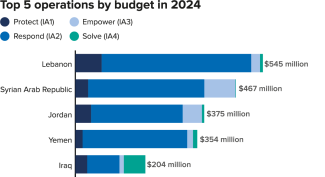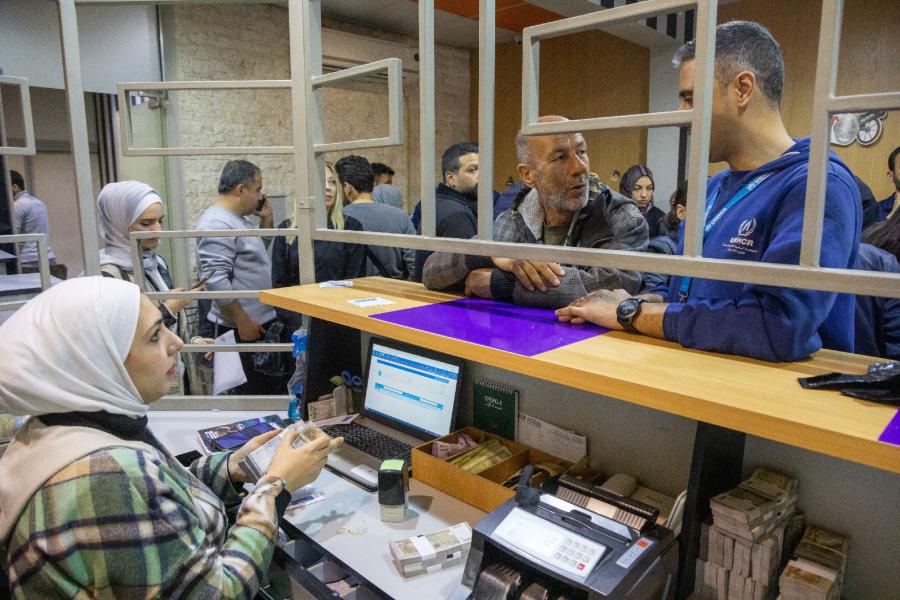2024 population planning figures
15.8 million forcibly displaced and stateless people¹ | 12% of global total

Regional overview
The region's protracted humanitarian crises and political and security challenges will continue in 2024. A string of new emergencies struck the region in 2023, adding to existing crises, while the war in Ukraine reversed some of the economic gains made since the pandemic. The latest shocks include devastating earthquakes in Türkiye and the Syrian Arab Republic, natural disasters in Morocco and Libya, and a civil war in Sudan that has driven refugees into Egypt, another country with a fragile economy.
All this increases the hardship experienced by forcibly displaced and stateless people and their host communities, exacerbating their vulnerability, depleting their resources and straining social cohesion. The risks – including exploitation, smuggling, trafficking, refoulement, expulsions, arrest and detention – increase the need for UNHCR’s protection work while making it harder to bring each person’s displacement or statelessness to a satisfactory end. A total of 11.7 million people in the region are expected to be displaced within their own country in 2024, and UNHCR hopes to reach 5.8 million of them with assistance.
The Syria crisis remains the region’s largest cause of displacement, with over 5.3 million registered Syrian refugees in Türkiye, Lebanon, Jordan, Iraq, Egypt and North Africa. Syrians are still being displaced and conditions are not conducive to large-scale voluntary returns, with fewer than 40,000 returning in the first nine months of 2023. Support for refugee-hosting countries is crucial. In Lebanon, for example, one of the largest refugee-hosting countries in the world, nine out of 10 refugees live in extreme poverty.


Resettlement and complementary pathways remain the most viable solution to forced displacement in the region. Including Syrians in Türkiye, 848,000 vulnerable refugees will need resettlement from the region in 2024, 753,000 of them Syrian. Syrians are the nationality with the highest resettlement needs globally.
Movements from sub-Saharan Africa towards North Africa, combined with fewer safe routes to asylum, add to the pressures on UNHCR’s systems and resources. Sea departures have significantly increased from the Horn of Africa to Yemen, where two thirds of the population depend on humanitarian assistance and the protracted conflict still produces localized escalations around contested areas. In 2024, UNHCR plans to increase cash assistance in Yemen for IDPs and returnees and shift towards sustainable local settlements.
Where possible, UNHCR will press for people’s inclusion in national services and social protection systems. Progress is foreseen in Mauritania and in Iraq, where people will be included in public services instead of receiving individual humanitarian assistance, resulting in a reduction in UNHCR’s staffing and budgeted needs for 2024.
UNHCR will pursue advocacy with governments, leveraging Global Refugee Forum pledges, and stronger partnerships, to ensure protection and safety, especially for those who are unable to repatriate. In conjunction with UNDP and partners, UNHCR will seek to update the Regional Refugee and Resilience Plan (3RP), the main platform for coordination, planning, advocacy, fundraising and programming in the Syria crisis.


To address the effects of climate change on displacement, UNHCR will enhance early warning, early action and early recovery plans in Mauritania, where 60% of the population live in highly water-stressed areas, and in Iraq, where 20,000 people have been displaced by droughts in central and southern governorates. Area-based programming will focus on strengthening resilience and reduce vulnerability to enable forcibly displaced and host communities’ positive coping mechanisms and recovery from the impacts of climate change, including onward or new forced displacement.
UNHCR will continue engaging with development and humanitarian actors and other Global Compact on Refugees partners to share knowledge, resources, and best practices in line with the “Operational strategy for climate resilience and environmental sustainability 2022-2025”.
Overall, the 2024 proposed budget will decrease by $99.9 million, or 4%, compared to the 2023 current budget, partly due to the temporary needs arising from the earthquake, and the transition in Iraq. By the end of 2024, the number of forcibly displaced and stateless people in the region is projected to decrease to 15.8 million, or by 2%.
For the latest operational and funding updates on the Middle East and North Africa region check this page.
